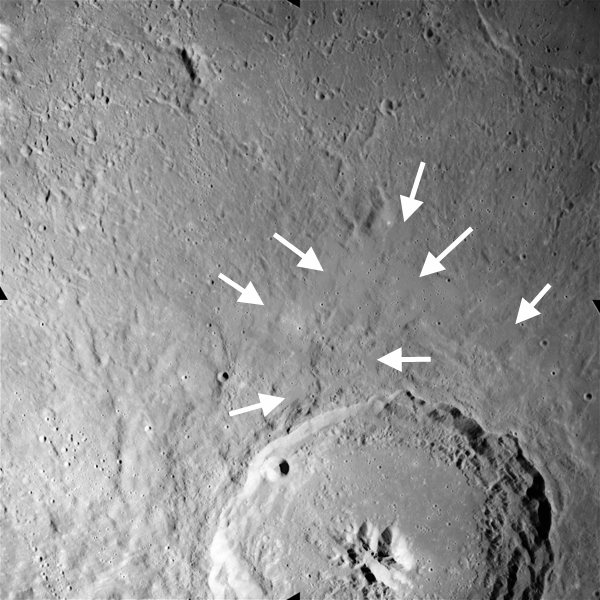
| Project Home | About the Scans | Browse Gallery | Image Map | Support Data | Resources | Ephemeris |
Featured Image - 01/20/2009
Theophilus Crater: Making Cosmopolitan Regolith
Theophilus is a complex crater (100 km diameter) with a distinctive ejecta blanket. It is nestled amongst Sinus Asperiatatis, Mare Nectaris, and the nearside central lunar highlands. Theophilus crater displays (Figure 1, AS16-M-0432) terracing in its walls and a central peak, features that are typical of craters this size. The floor of the crater is smooth and flat because it was filled with impact melt. Impact melt is rock and debris that melted during the impact, pooled in the low regions, and then cooled into a smooth, solid deposit. Impact melt is also found outside Theophilus crater in the ejecta, seen as smooth looking "ponds" shown by the arrows in Figure 1
Figure 1: Northern portion of Theophilus crater and its ejecta.
Crater walls are terraced like most craters of this size. Remnants of
the central peak structure are visible. Impact melt formed flat, smooth
deposits in the floor of the crater and in the ejecta (white
arrows).
(Apollo Image
AS16-M-0432 [NASA/JSC/Arizona State University])
It turns out that two of the Apollo missions may have sampled materials ejected by the Theophilus impact vent. Theophilus is roughly 350 km southeast of Tranquillity Base. Apollo 11 mission planners noted that the southern part of Mare Tranquillitatis is crossed by crater rays, at least one of which is thought to be from Theophilus (Beaty and Albee, 1980). It was hoped that materials ejected from the Theophilus impact event might be found at the Apollo 11 landing site, thus enabling lunar scientists to determine when the crater was formed. Lunar sample investigators have since tenatively identified materials consistent with a Theophilus origin amongst the Apollo 11 samples, a conclusion supported by some recent remote sensing investigations of the region (Staid et al., 1996)
Theophilus is also approximately 300km west of the Apollo 16 landing site at Descartes in the central nearside highlands. While almost all of the rocks found at the Apollo 16 landing site are breccias -- rocks composed of other rock and mineral fragments fused together during large impacts -- the findings included several basaltic fragments. These basaltic fragments are most likely debris from nearby impacts. Some of the fragments are enriched in titanium and are thought to originate from multiple impacts in Mare Tranquilitatis (approximately 300 km to the north) (Zeigler et al., 2006). Other fragments have less titanium and are thought to originate from Mare Nectaris and Sinus Asperitatis (approximately 220 km to the east) (Zeigler et al.). The basalts originating from Mare Nectaris and Sinus Asperitatis were probably transported during the Theophilus impact.
These two examples of materials being transported over hundred of kilometers illustrate that rocks and soils collected at the Apollo landing sites are a complex mixture of local materials and those transported during nearby impact processes. With so many impact craters on the Moon, materials with different compositions and origins can readily become mixed.
References:
Apollo Over the Moon: A View from Orbit (1978) H.
Masursky, G.W. Colton, F. El-Baz, eds. NASA SP-362. http://www.hq.nasa.gov/office/pao/History/SP-362/contents.htm
D. W. Beaty and A. L. Albee (1980) The Geology and Petrology of the
Apollo 11 Landing Site. Proceedings of the 11th Lunar and Planetary
Science Conference: 23-35.
M. I. Staid, et al. (1996) Mare Tranquillitatis: Basalt emplacement history and relation to lunar
samples. J. Geophys. Res., 101:E10, 23,213-23,228.
R. A. Zeigler, et al. (2006) Petrography and Geochemistry of
Five New Apollo 16 Mare Basalts and Evidence for Post-Basin Deposition
of Basaltic Material at the Site. Meteoritics and Planetary Science, 41:
159-328.
Tweet
![]()

|
|
Space Exploration Resources |
|
 LPI LPI
|
